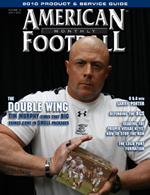Article CategoriesAFM Magazine
|
Sickle Cell Trait in Football: Educating Coaches© More from this issueby: McCall Parrish, AFCA & Tai M. Brown, AFCA In the past 10 years, 20 NCAA football players have lost their lives to non-traumatic football deaths. Of those 20, 16 deaths occurred in conditioning activities while the other four occurred in day one or day two of preseason football practice. The question has to be asked: Are we training our football players to death? Exertional sickling is the leading cause of death of college football players in this decade and all cases have occurred during conditioning sessions. Sickle cell trait related deaths are certainly preventable. In order to prevent this from happening, one needs to know the si....The full article can only be seen by subscribers.
|
|
|||||||
| HOME |
MAGAZINE |
SUBSCRIBE | ONLINE COLUMNISTS | COACHING VIDEOS |
Copyright 2025, AmericanFootballMonthly.com
All Rights Reserved





